Changes in Islandness Seen through the Sea Region Linguistics
Abstract
The boundary between land and island is blurring. This may be attributed to the shortened physical distance and changes in the psychological distance. This study aimed to identify why the boundary that sets apart the island from the land is blurring. In the fast-changing socio-cultural context, the island has often been covered by the media as a place for healing. As a result, the number of tourists in islands has increased, and their psychological and physical distances with the land have become closer through bridges connecting the mainland and island. It can be interpreted that the boundary between the land disappeared as islands became more accessible than before. On that basis, this study aimed to examine how islands have been portrayed in the media and the research trends and identify the changes in “islandness” by analyzing the changes in the language in the island, with a focus on the island of Udo. As a result, this study found that the linguistic landscape, with its multilingual signs and the increase in amenities, has led to a rise in the number of tourists.
Keywords
Islandness, Linguistic Landscape, Udo Island, Change Perception, Sea Region Linguistics
Introduction
What is islandness? The dictionary's answer to this basic question is as follows. An island is a piece of land that is smaller than Australia, which is the smallest continent in the world and is surrounded by water, such as oceans and lakes. In Chinese characters, it is written as "島嶼," "嶼" signifying a small island. In English, it is called "island," which is a coined word made by combining the root word "is," which means water, and "land."
While including the concept of islandness that shares the openness and interaction of the island caused by differences in geography, topography, and spatial distribution as well as marine thinking, along with the traditional island specificity based on continental perception, the island has it is existence, an identity, and a future-oriented direction (Hong & Pungetti, 2012). The closer the distance between the island and the land, the stronger the function as a boundary that reproduces the past time and space, but confirmed how it affects the cognitive system from the perspective of the island residents and outsiders. (Kim, C. W, 2021).
The image of the island in the media has become increasingly positive. In the past, most reality-variety shows were based in cities. However, reality-variety shows have left the city and began filming near the sea in fishing villages and islands. More recently, the boundary between land and island has blurred. This may be attributed to the shortened physical distance and changes in the psychological distance. This study aimed to identify why this boundary between the island and the land is blurring.
As mentioned above, "islandness" encompasses the meaning of isolation and communication. Islands will be permanently isolated and be unable to obtain the opportunity to communicate unless their residents cannot lead a convenient lifestyle (Kim, 2008). This is why there has been a direct and indirect increase in transportation and amenities. This study thus examined the changes in islands and their islandness from a linguistic point of view.
In the fast-changing socio-cultural context, the island often appears in the media as a place for healing. As a result, the number of tourists in islands has increased, and their psychological and physical distances with the land have become closer through bridges connecting the mainland and islands. In other words, the boundary between the land disappeared as islands became more accessible. This study used the “linguistic landscape” approach to support this hypothesis. By focusing on the chronological changes in the signage in an island, this study presented how a mystical island has been transformed into a familiar and accessible island.
Literature Review
Islands in the media
From a certain moment, variety programs such as “Three Meals a Day - Fishing Village (Manjaedo in Shinan-gun, Jeollanam-do, Deukryangdo in Goheung-gun, Jukguldo in Wando-gun),” “It’s Good if We Don’t Fight (Hwangdo in Boryeong, Chungcheongnam-do),” “Udo Jumak (Udo, Jeju Island),” and “2 Days & 1 Night” have begun to air programs that are based in islands. They began to take the form of reality-variety shows that escape the city and take place in the sea, fishing villages, and islands. Relevant programs can be found in Table 1. This trend has intensified recently due to COVID-19. For instance, the TV show Three Meals a Day is promoted as follows. “On a small island beyond the horizon at the edge of the southern coast, in a quiet place where no passenger ship stops by, a family of three begins to live the island life.” In this way, the island is portrayed as a place untouched by people. Also, another variety TV show called “Udo Jumak” was broadcast in 2021, which was a program set in Udo in Jeju Island for newlyweds who were getting married in the pandemic. This program was also based in “Udo,” which was advertised as an “island within an island” and a place one has to bother to travel further, rather than being an easily accessible healing spot.
| Broadcast Period | Promotional Poster | Program | Broadcast Period | Promotional Poster | Program |
|---|---|---|---|---|---|
| 2007-Current | 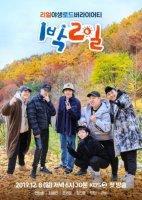 |
2 Days & 1 Night (KBS) | 2005-2006 | 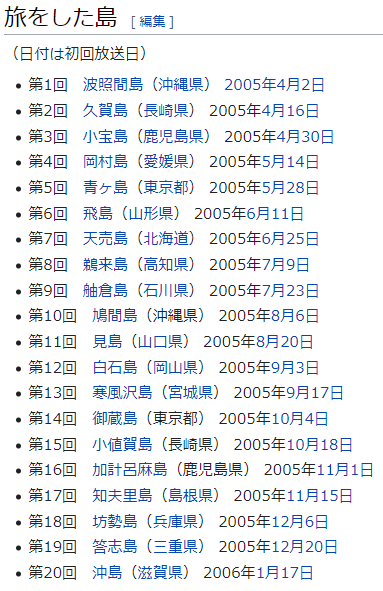 |
Island Trip - BS Nippon TV |
| 2015-2020 | 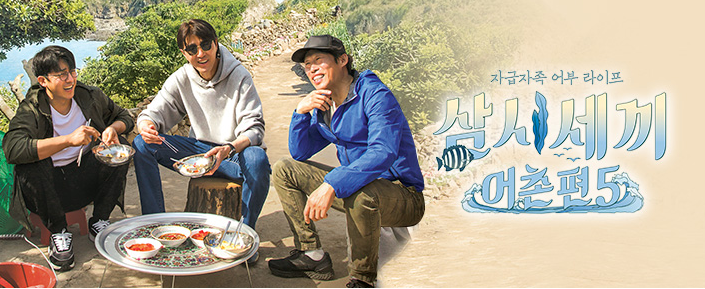 |
Three Meals a Day - Fishing Village (tvN) | Irregular Schedule |  |
Remote Island Bar (Travel Channel) |
| 2017-2018 |  |
Island Trio (Olive・tvN) | 2018 | 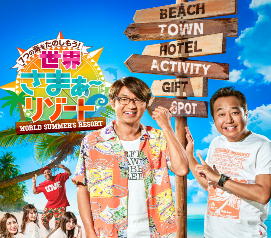 |
Enjoy the Seven Oceans! World’s Summer Resorts (TBS TV) |
| 2021 | 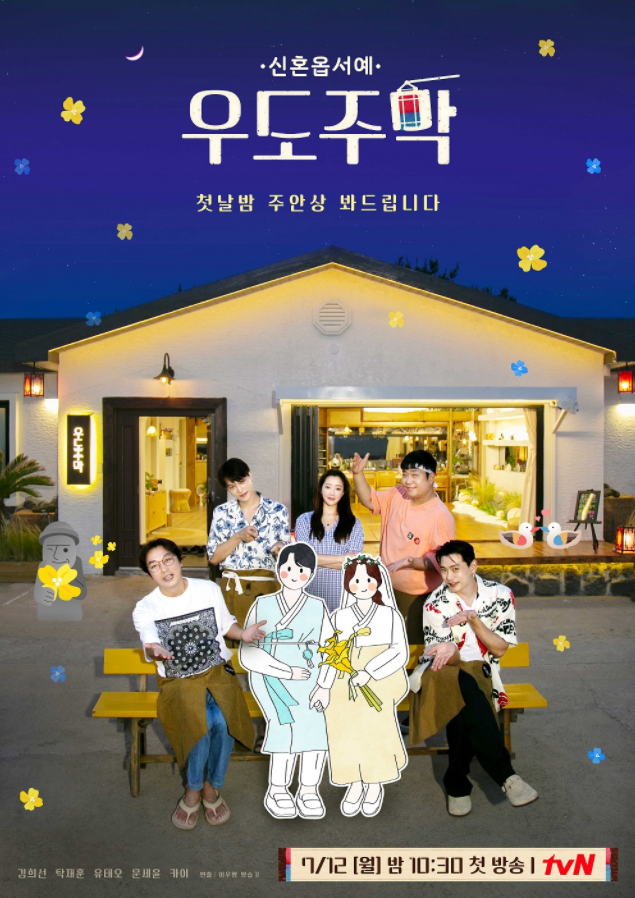 |
Udo Jumak (tvN) | 2019 | 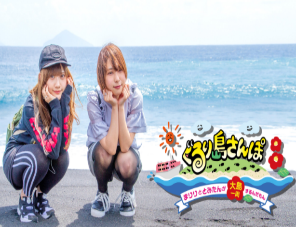 |
A Walk around the Island (BS11) |
| 2020-Current | 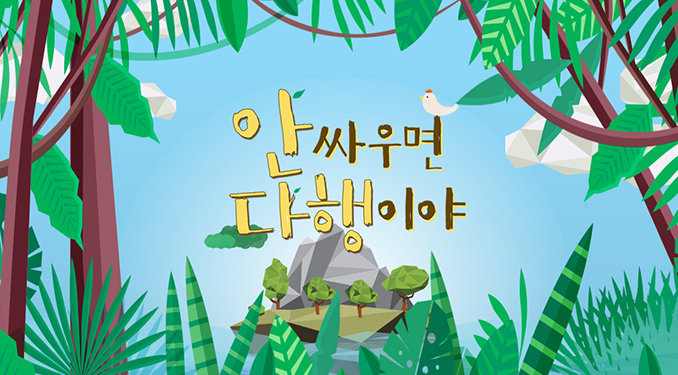 |
It’s Good if We Don’t Fight (MBC) | 2020-2021 | 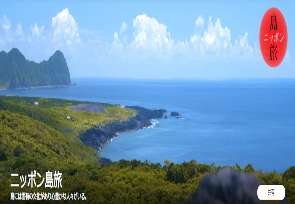 |
Trips to Japanese Islands (NHK) |
In the case of Japan, TV shows have taken the form of educational documentaries that travel Japanese islands and introduce the unique culture, heritage, history, and natural environment of each island, as the guides transmit various information to their viewers. Most information concerns the island's cultural patterns and natural environment, while historical events are also introduced. The TV shows took a similar format to the Korean TV shows by focusing on introducing the history and life of the residents through the trip or trips featuring traditional liquor from the islands, or short trips to Izu, Oshima, that is, islands that are in an hour's distance from cities, which introduces various experiences, food, and scenery under the theme.
Research Trends on Islandness
Kwak (2016) posited that an island can be perceived as a "stepping stone for communication" as well as a "symbol of isolation." This is how "islandness" can be defined. An island represents both isolation and communication. At one point, it is an independent place isolated from the land, but then again, an island can serve as a stepping stone to becoming an entirely new space. "Islandness," therefore, cannot be defined as a single characteristic. An island is a complex space, so it is necessary to examine several studies to understand "islandness."
Recent studies related to islandness show that the variety of research is lacking compared to the emerging interest in the topic (Ronström, 2021; Lee & Jung, 2012). Kim (2015) found that islandness in terms of the natural environment was more valued than islandness in terms of culture regarding island tourism. It was found that TV variety shows implicitly captured the significance of island tourism through various experiences and emotional messages and that they instill a positive image in their viewers as the symbolic meaning of island tourism becomes "healing" and "islandness" is used as a mechanism of persuasion (Park & Jang, 2017). More recently, by focusing on the islands in Shinan-gun, it was presented the development of tourism content, the tourism industry, and added value of tourism as ways to promote sustainable island tourism and maximize the value of islandness (Jo et al., 2021).
As of 2021, South Korea is one of the representative island countries with a total of 3,383 islands, including 456 inhabited islands and 2,918 desert islands. In Asia, it has the fourth-largest number of islands after Indonesia, the Philippines, and Japan, and is considered one of the world's top 10 island countries. The government has implemented island promotion policies to utilize such physical resources, but these policies should be pursued while preserving the islands' unique characteristics (Kim, 2012).
In the past, an island was viewed as a place where people make a living through activities centered on the primary industry, that is, by collecting fishery. However, in the twenty-first century, the lifestyles of the island residents are changing in accordance with the changing world by focusing on the keyword "sustainable development" (Hong, 2017). Also, looking at the recent research trend of islandness, the future of sustainable island and the value of island to secure sustainability were discussed from the perspective of changes in island humanities and island identity due to ocean recognition, changes in the global environment and natural resources focusing on ecological and cultural backgrounds and methodologies (Hong, 2022).
Changes in Islandness found in the Linguistic landscape
Linguistics is the science of languages. It aims to understand the features that all natural human languages share: how languages are structuralized, how they change, how they are acquired, and how individuals and groups use languages for communication. Since islands are undergoing rapid socio-cultural changes, and the so-called "islandness," which is their identity, is also transforming, island research is at a critical juncture that calls for more attention. Based on the linguistic landscape, it may be necessary to redefine islands due to the construction of the numerous bridges connecting the islands to the mainland (Kim, 2013).
Linguistic landscape indicates all visual elements that can be seen through one's eyes (Landry & Bourhis, 1997). It encompasses all visual languages, including road signs, advertising signs, place names, store signs, and government office signs (Yang & Kim, 2021). The most easily accessible linguistic landscape material is store signs. Before explaining the linguistic landscape in detail, this study focused on the island of Udo, a brief explanation of which is as follows.
Overview of Udo
Udo is an island situated in the far east of Jejudo and is the second-largest island in Jeju Special Self-Governing Province. The island was named after its shape, which resembles a lying cow. The island area is 6.18km2, which is about one-hundredth the area of Seoul. The island’s population as of June 2021 was 1,722 (903 males and 819 females). It consists of four Ri (village), twelve villages, and 20 ban.
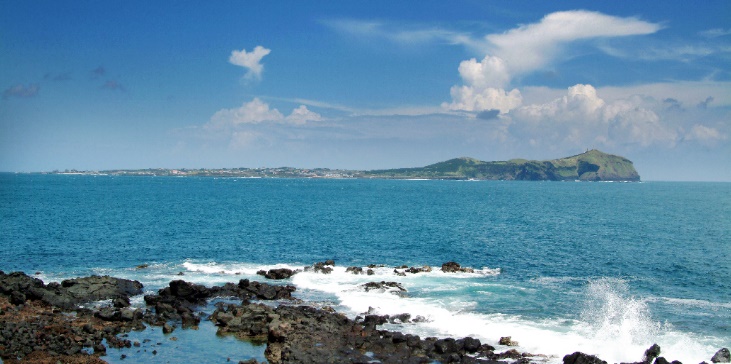
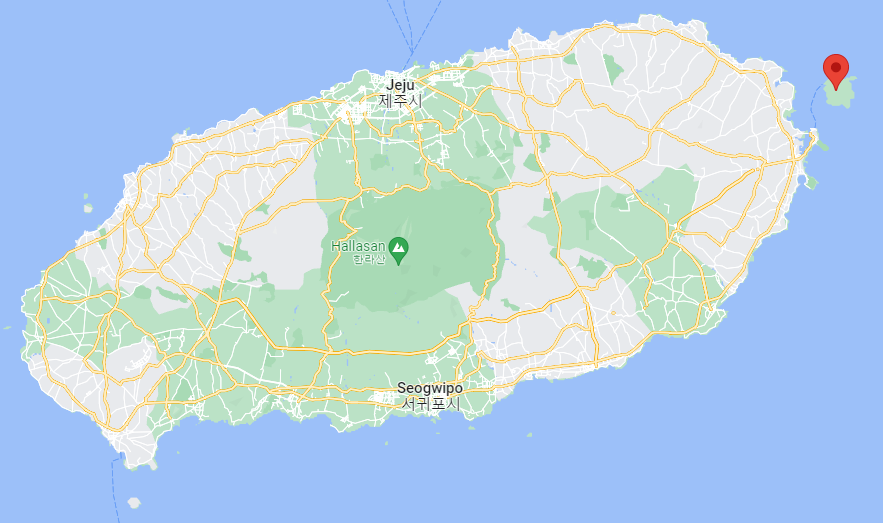
The islands introduced in TV programs are constantly visited and stimulate the island’s economy. However, frequent media exposure has its merits and faults.
For instance, media exposure is welcoming news for island residents who work on island tour packages. However, the large number of visitors may harm the island’s natural ecosystem. In any case, reality-variety shows about islands began to air in 2015, and it can be seen that the rise in the number of island-related programs affected the number of tourists visiting the islands. While this study does not cover this in detail, numerous bridges that connect land and island were constructed, thereby blurring the boundary between land and island.
There are a total of 47 bridges that connect the land and the island in Korea: five in Incheon, three in Incheon and Gyeonggi-do, one in Jeollabuk-do, seven in Gyeongsangnam-do, one in Gyeongsangnam-do and Busan, five in Busan, and 23 in Jeollanam-do. Most bridges that connect the land and the island are in Jeollanam-do, where many islands are situated. This is because the islands’ population dropped and aged and the island community weakened, leading to a paradigm shift in the island area. The islands’ residents moved to the land and the islands became an ambivalent space that only plays a pivotal and active role in fishing seasons.
| Region | Name | Location | Length | Opening Date |
|---|---|---|---|---|
| Busan | Gadeok Bridge | Nulcha-dong - Songjeong-dong, Gangseo-gu | 960m | December 14, 2010 |
| Namhyang Bridge | Amnam-dong, Seo-gu — 4-ga, Yeongseon-dong, Yeongdo-gu | July 9, 2008 | ||
| Busan Bridge | 7-ga, Joongang-dong, Jung-gu — 1-ga, Bongrae-dong, Yeongdo-gu | 694m | January 30, 1980 | |
| Busan Harbor Bridge | Cheonghak-dong, Yeongdo-gu — Gamman-dong, Nam-gu | May 22, 2014 | ||
| Yeongdo Bridge | 1-ga, Nampo-dong, Jung-gu — 1-ga, Daegyo-dong, Yeongdo-gu | 214.8m | November 27, 2013 | |
| Jeollanam-do | Geogeum Bridge | Sinchon-ri, Geumsan-myeon, Goheung-gun — Doyang-eup, Sorok-ri | 2028m | December 16, 2011 |
| Geobukseon Bridge | Woodu-ri, Dolsan-eup, Yeosu — Jonghwa-dong | |||
| Gogeum Bridge | Gagyo-ri, Gogeum-myeon, Wando-gun — Maryang-ri, Maryang-myeon, Gangjin-gun | |||
| Kim Dae-jung Bridge | Bokryong-ri, Aphae-eup, Sinan-gun — Seongnae-ri, Unnam-myeon, Muan-gun | December 27, 2013 | ||
| First Naro Bridge | Namseong-ri, Podu-myeon, Goheung-gun — Deokheung-ri, Dongil-myeon | |||
| Second Naro Bridge | Singeum-ri, Bongrae-myeon, Goheung-gun — Bongyoung-ri, Dongil-myeon | |||
| Dolsan Bridge | Namsan-dong, Yeosu — Woodu-ri Dolsan-eup | 450m | ||
| Mokpo Bridge | Dal-dong, Mokpo — Jukgyo-dong | 3.06km | June 29, 2012 | |
| Baekya Bridge | Baekya-ri, Hwajeong-myeon, Yeosu — Anpo-ri, Hwayang-myeon | 325m | April 14, 2005 | |
| Cheonsa Bridge | Sinseok-ri, Amtae-myeon, Sinan-gun — Songgong-ri, Aphae-eup | |||
| Seonammun Bridge | Balmae-ri, Docho-myeon, Sinan-gun — Sudae-ri, Bigeum-myeon | |||
| Sorok Bridge | Sorok-ri, Doyang-eup, Goheung-gun — Bongam-ri | 1160m | March 2, 2009 | |
| First Shinan Bridge | Majin-ri, Anjwa-myeon, Sinan — Jangchon-ri, Palgeum-myeon | |||
| Shinji Bridge | Gayong-ri, Wando-eup, Wando-gun — Songgok-ri, Sinji-myeon | |||
| Aphae Bridge | Sinjang-ri, Aphae-eup, Sinan-gun — Daeyang-dong, Mokpo | May 22, 2008 | ||
| Yaksan Bridge | Deokdong-ri, Gogeum-myeon, Wando — Woodo-ri, Yaksan-myeon | |||
| Wando Bridge | Wondong-ri, Gunoe-myeon, Wando-gun | March 29, 2012 | ||
| Eunam Bridge | Osang-ri, Amtae-myeon, Sinan-gun — Yugak-ri, Jaeun-myeon | |||
| Joongang Bridge | Wonsan-ri, Palgeum-myeon, Sinan-gun — Wachon-ri, Amtae-myeon | |||
| Jeungdo Bridge | Jeongdong-ri, Jeongdo-myeon, Sinan-gun — Tandong-ri, Jido-eup | |||
| Jido Bridge | Tandong-ri, Jido-eup, Sinan-gun — Eupnae-ri | |||
| Hoejin Bridge | Dae-ri, Hoejin-myeon, Jangheung-gun — Noryeokdo, Noryeok-ri, Hoejin-myeon | |||
| Jindo Bridge | Nokjin-ri, Gunnae-myeon, Jindo-gun — Hakdong-ri, Munnae-myeon, Haenam-gun |
As can be seen in Table 2, the convenient mobility the bridges provide is breaking down the boundary between land and island. Although the less visited islands have their charms, the general public has chosen to pursue convenience on the islands.
Islandness of Udo Seen through the Linguistic Landscape
This paper focused on the islandness of Udo by using various signs, including the sign shown in Figure 2, as examples of the change in the island’s linguistic landscape.
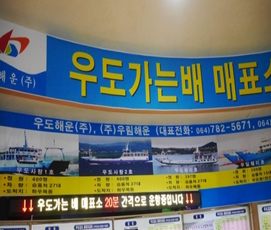
Using the roadview function in Daum, a Korean portal website, it is possible to compare the past and current images of a specific location without visiting the spot in person. This method is a new paradigm in linguistic landscape research, which is commonly used nowadays. The linguistic landscape of Udo, Jeju, which was featured in TV shows, was as follows.
As can be seen in Figure 3, the number of visitors to “Udo,” which is an island within an island visited by people who visit Jeju Island, has increased sharply from 2015 and has gradually declined since 2019. The number decreased when rental cars were restricted from entering Udo in August 2017 and has somewhat increased as the restriction was lifted for drivers who will be using accommodations in Udo in March 2018.
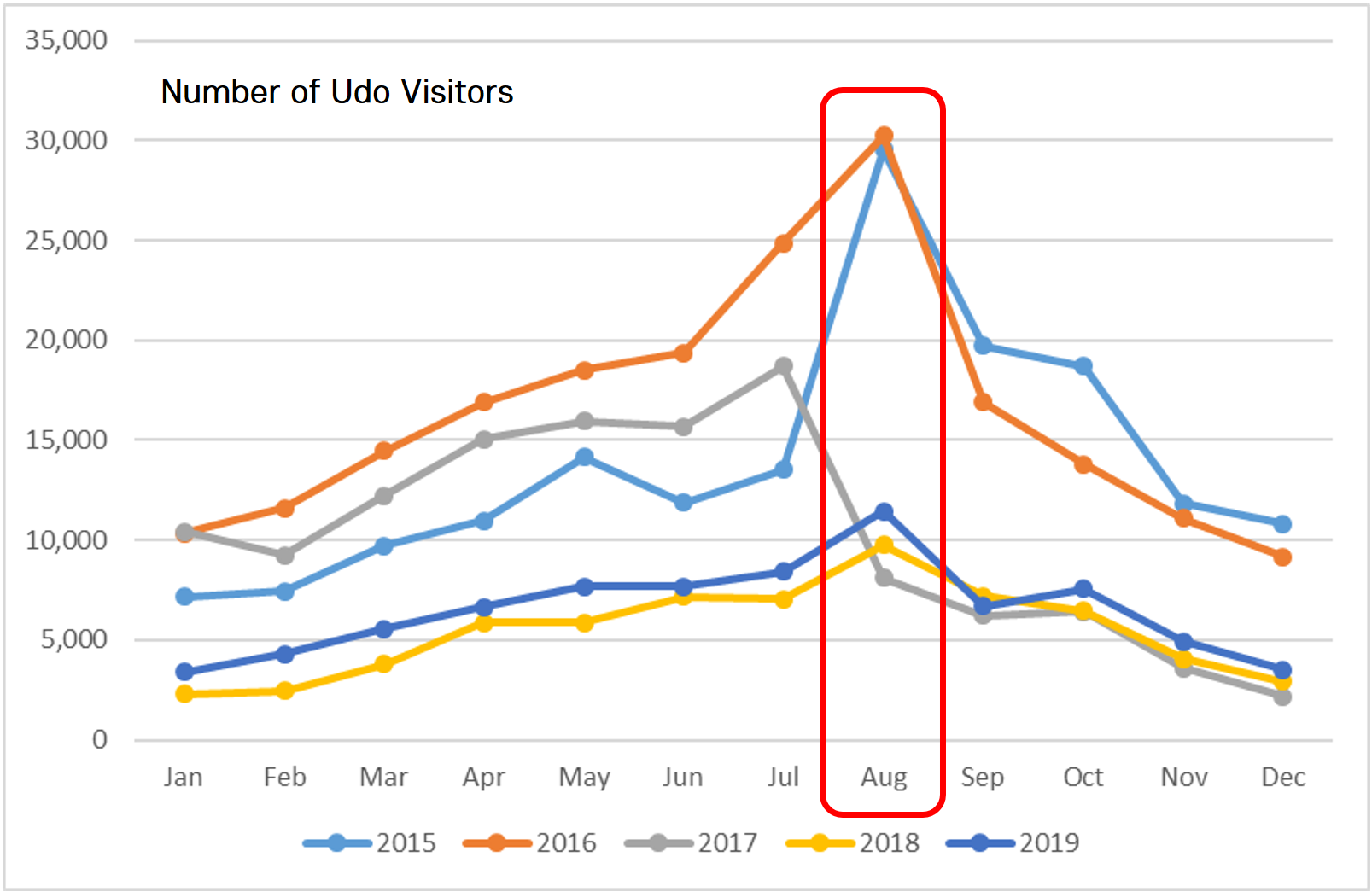
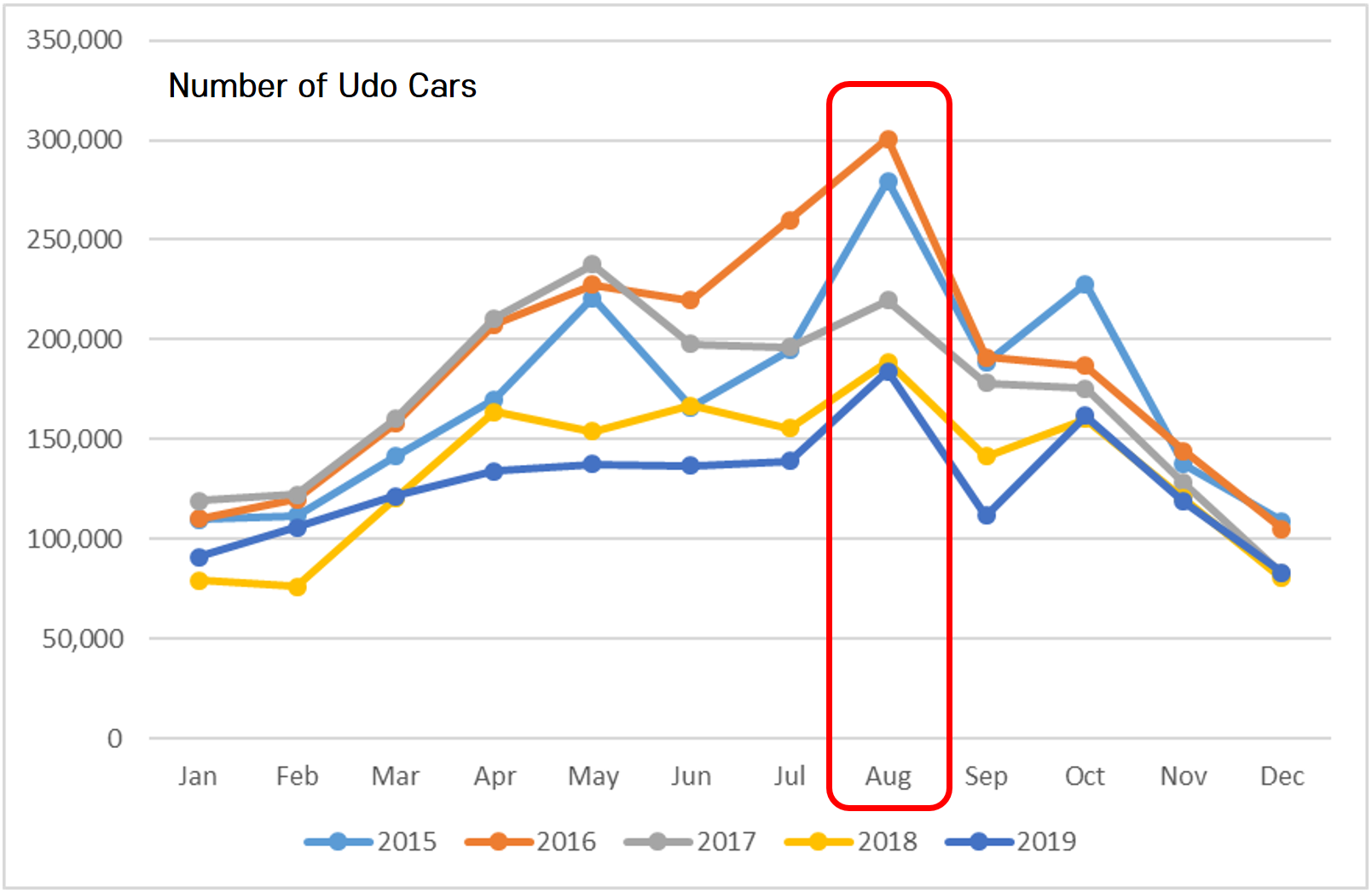
To examine the linguistic landscape of Udo, this study presented the linguistic landscape materials found using the roadview function in Daum, as can be seen in Figure 4.
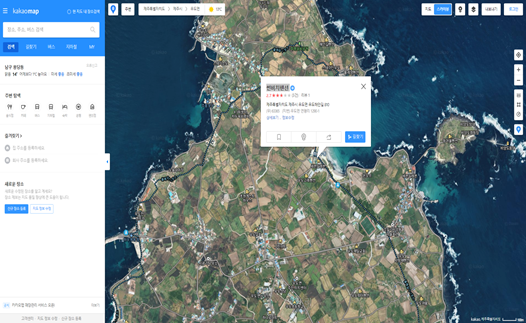
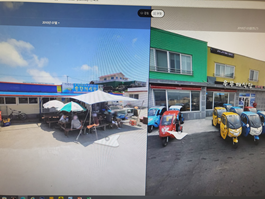
Figure 5 was a result of searching for “Sun Beach Pension” in Udo in Daum Roadview. While there was a building in 2018, it was not in a renovated state. However, the photo taken in 2018 showed that the name of the business was changed from “Sun Beach Bed & Breakfast” to “Pension” and that “SUN BEACH” was also written in Roman alphabets on the sign. This study also found that a convenience store called “7-Eleven” was newly established, along with the demand for more restaurants due to the increase in tourists.
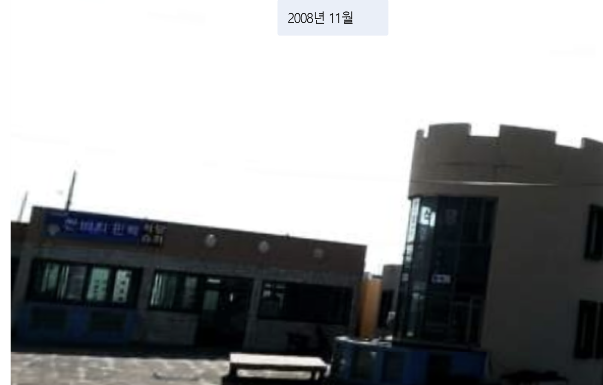
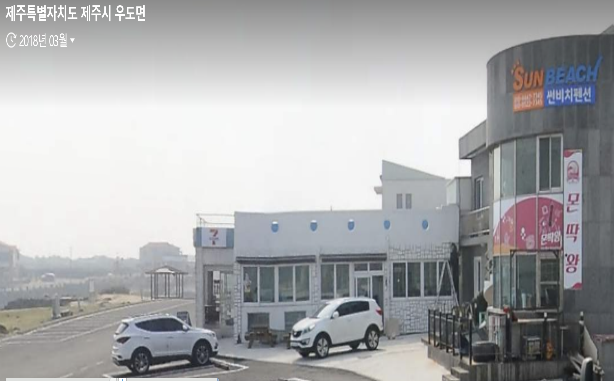
The rise in the number of visitors led to a refashioning of a bed and breakfast to a pension, and an increase in the number of convenience stores, which are indispensable to people nowadays, in every corner of the island. This study indirectly witnessed how an island, which was not very crowded and seldom visited by people, has become similar to a place on the mainland. As mentioned above, while the general public was enticed by the isolation the mystical island could provide, they also began to demand amenities and quality accommodations.
Another place this study focused on was the changes in the peanut ice cream shop, which is one of Udo’s main attractions. When one searches for “Jimmy’s” Udo Peanut Ice Cream Shop in Daum Roadview, they would be able to see the following image.
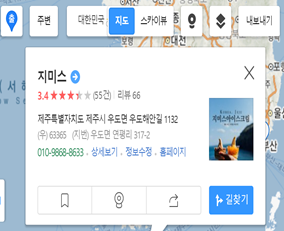
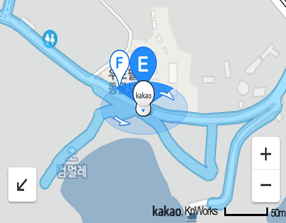
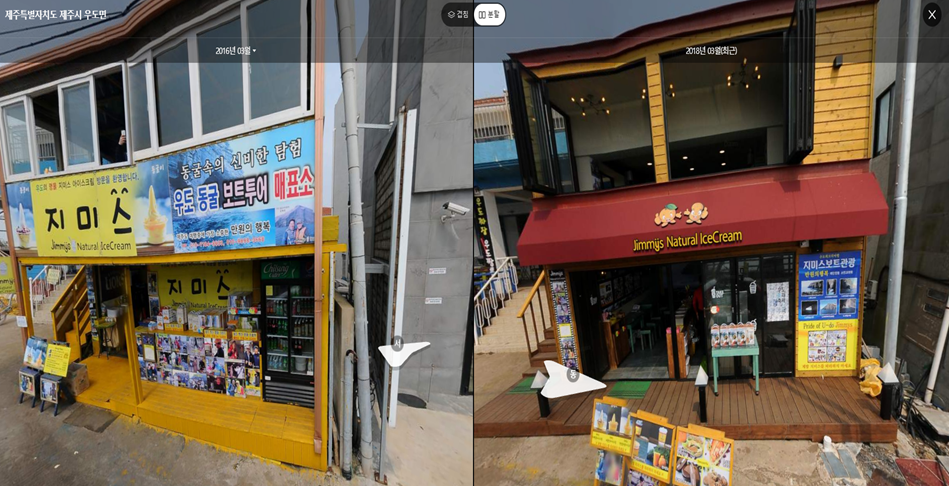
As shown in Figure 6 the sign of the ice cream store changed into Roman characters to create a more aesthetic and sophisticated effect. The sign, which was entirely in Korean, was changed entirely into Roman characters, improving the store’s image rather than effectively delivering the information. In other words, this store intended to use the early effects Roman characters had in Korea, of being exotic and more refined.

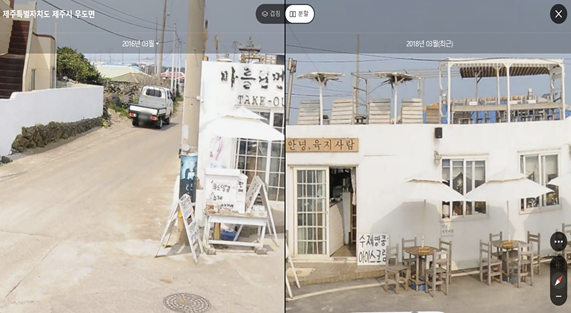
Finally, as can be seen in Figure 7, the store that used to be a brunch restaurant called Marilyn Monroe in 2016 was turned into a handmade peanut ice cream store called “Hello, Land People,” according to a photo taken in 2018. The store switched its business to fully promote Udo peanuts, a local specialty product. The sign, “Hello, Land People,” which can be directly perceived in the linguistic landscape, also confirmed that the store targets tourists rather than the island residents. In this way, the signs show that Udo, which was an isolated island in the past, is transforming into a place for communication due to the influx of tourists. The linguistic landscape also showed that many businesses have opened and closed in accordance with the changing trends of the visitors that come to the island.
Conclusion
The island once symbolized isolation, but the boundary between land and island disappeared because of mass media and various social changes. Consequently, the meaning of “islandness” has changed, and islands have become a spot for healing where people can enjoy all the amenities that can be found on the mainland. The changed perception of the island has also led to the rise in the number of tourists, as the complexity of the islands was revealed to the public. The implications of this study were as follows:
- The psychological distance with islands was only shortened when the physical distance was shortened.
- Rather than the inconvenience of the islanders, islands with convenient facilities display the image of “islandness” that can be developed sustainably.
- An analysis of the linguistic landscape showed that the increase in visitors could weaken the identity of “islandness.”
- The linguistic landscape of Udo pursued sophistication by using more Roman characters rather than Korean characters, just as is the case in the mainland.
- Businesses that used local specialties were more responsive to tourists’ trends.
- A new possibility of researching islands, by combining IT in the era of the fourth industrial age, such as Daum Roadview, was presented to study islands that can be isolated.
Therefore, it was possible to bring diversity to research in that this study expanded into a new topic in the field of island research in a situation where the sea network is being reorganized into the mainland network. This was significant as this study presented how island development can maintain its unique characteristics and establish new bases and how the “islandness” can be maintained. It was also significant as this study suggested a new direction in the field of island research that has not been visited in previous studies.
Moreover, this paper confirmed how multilingual signs and the increase in amenities have led to a rise in tourists. However, from the perspective of an island or sea region researcher, islands will lose the mystical and attractive characteristics unique to islands if the changes in the “islandness” result in the islands to become similar to the mainland. Measures to revitalize the islands remain a challenge for the future.
Acknowledgments
This work was supported by the Ministry of Education of the Republic of Korea and the National Research Foundation of Korea (NRF-2017S1A6A3A01079869).
Endnotes
References
- Hong, S. K., 2017. Interdisciplinary Suggestion for Sustainable Islandness and Improvement of Islander's Economy Quality. Journal of Multiculture and Education, 2(1): 37-55.
- Hong, S. K., 2022. Changes in the Island Humanistic Topography and the Island Identity due to Global Environmental Changes: Focused on the Ecological-cultural Background and Methodology. Cultural Exchange and Multicultural Education, 2(40): 417-441. (https://doi.org/10.30974/kaice.2022.11.2.17)
- Hong, S. K., Pungetti, G. (2012). Marine and island cultures: A unique journey of discovery. Journal of Marine and Island Cultures, 1(1): 1-2. (https://doi.org/10.1016/j.imic.2012.06.001)
- Jo, H. N., Kim, M. J., Jeon, Y. M., 2021. A Study on the Promotion of Sustainable Island Tourism: Focusing on Islands in Shinan-gun. Journal of Convergence Tourism Contents, 7(2): 121-136. (https://doi.org/10.22556/jctc.2021.7.2.121)
- Jeju Tourism Statistics, Jeju Tourism Association, http://www.visitjeju.or.kr/web/bbs/bbsList.do?bbsId=TOURSTAT
- Kim, C. W., 2021. Humanistic Reflection of Changes in Island Identity Seen From the Viewpoint of the Refugee Issue-With a Special Focus on Modern and Boundary Notions. Journal of the Island Culture, 57: 33-57. (https://doi.org/10.22917/island.2021..57.33)
- Kim, J., 2008. A study on the reality of island tourism and how to invigorate it -With the focus on islands and costal areas in South Jeolla-. Journal of the Island Culture, 32: 3-40.
- Kim, J., 2012. The reflection on the Islands Development Policies and Alternatives for Sustainable Islands Making. Journal of the Island Culture, 40: 427-456.
- Kim, J. I., 2015. Evaluation Factors of Island Tourism Amenity Using the AHP. The Journal of Humanities and Social science, 6(2): 301-318.
- Kim, S. J., 2013. An Ecological Study of Language in Islets near Jeju Island -Ocean Vocabularies in U, Biyang, Gapa and Mara Islet. Tamla Culture, 43(0): 67-100. (https://doi.org/10.35221/tamla.2013..43.003)
- Kwak, S. K, 2016. Two Views on Islands and the Effect of the Use of Genres - Focusing on the Spatial Background of Mamma Mia!-. Cine Forum, 23: 221-245.
- Landry, R., Bourhis, R. Y., 1997. Linguistic landscape and ethnolinguistic vitality: An empirical study. Journal of Language and Social Psychology. 16(1); 23-49.
- Lee, D. H., Jung, L. S., 2012. A Study on Research Topics and Characteristics of Island based on Bibliometric Analysis and Meta-Analysis. the Journal of Korean Island, 24(2): 49-66.
- Park, H. S., Jang, E. K., 2017. Semiotics Analysis of Island Tourism in TV Real Variety Entertainment Program. International Journal of Tourism Management and Sciences, 32(3): 159-175. (https://doi.org/10.21719/KJTR.32.3.9)
- Ronström, O., 2021. Remoteness, islands and islandness. Island Studies Journal, 16(2): 270-297.
- Udo, Google Maps, https://www.google.co.kr/maps/place/Udo/data=!4m5!3m4!1s0x350d154cd36ef703:0xf4d98d795dc0c78a!8m2!3d33.505439!4d126.9555616
- Udo Island Satellite image, https://ko.wikipedia.org/wiki/%EC%9A%B0%EB%8F%84#/media/%ED%8C%8C%EC%9D%BC:Udo_(satellite_image).jpg
- Udo Island, Visit Jeju, https://www.visitjeju.net/kr/detail/view?contentsid=CONT_000000000500477
- Yang, M. H., Kim, J. H., 2021. A Study on the Linguistic Landscape of Road Sign in Marine Tourism Cities: Focusing on Busan and Yokohama. The Society of Convergence Knowledge Transactions, 9(4): 75-86. (https://doi.org/10.22716/sckt.2021.9.4.045)
